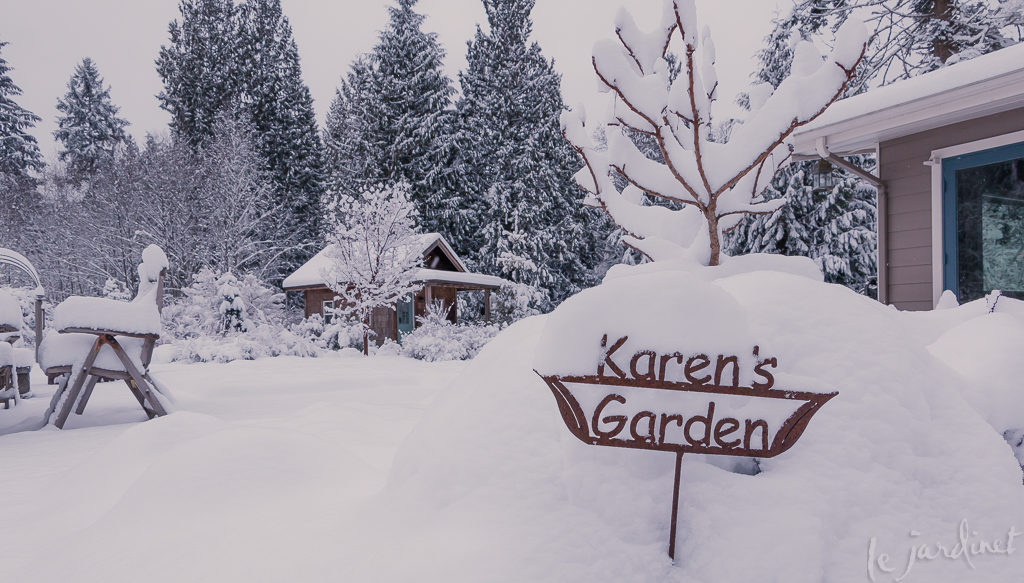Designing a Winter Wonderland

It's all very well knowing that for a garden to look good in winter it has to have "good bones". But what do you do when a foot or more of snow turns those bones into a lumpy graveyard? Seriously – since when do white lumps look like anything other than just white lumps?
When I went to bed last night there were just a few flakes falling gently. We woke abruptly at 4.30am to the sound of our frozen sump pump singing its last grating swan song, followed shortly after by our 1 year old puppy, Molly, growling at the deep blanket of snow that had fallen overnight.
I couldn't wait to get outside (in daylight) to take some snowy pictures of the pristine landscape. That idea was quickly abandoned as Molly tore outside with glee, snow-surfing, jumping, sliding, and running. And eating the snow. Which she then threw up – together with her breakfast – as soon as she came back inside. Clearly the serene aspect of any images I might take were lost.
One coffee later and suitably bundled up, I headed out into the moonscape. But what to take pictures of? I let my camera do the talking, drawing me to vignettes that told a story even though in that moment I didn't really understand what that story was about. Until I got back inside and looked at the images on my computer. I then quickly realized that my best snowy scenes were those that featured color, texture and/or form – elements that stood apart from the amorphous white blanket.
Color

Turquoise containers and a colorful glass sculpture create a dramatic counterpoint to the white backdrop
I have both blue and orange containers in my garden and they look stunning in the winter landscape – far more dramatic than the charcoal grey or rustic green ones I also have. This glass sculpture by Jesse Kelly is not hollow so is weather proof in my PNW climate.
Colored dogwood twigs would be another way to add color to a snowy scene but you would need a significant grouping of these to stand out. The colored bark of trees such as coral bark maple (Acer palmatum Sango Kaku), Bihou Japanese maple (Acer palmatum 'Bihou') or Pacific Fire vine maple (Acer circinatum 'Pacific Fire') would be sturdier and be easier to see. (Incidentally my white barked Himalayan birch trees (Betula utilis var jacquemontii) only stand out marginally in the winter garden when they are backed by tall evergreens. They are more eye catching in summer and fall.)
Textured bark
 River birch (Betula nigra 'Heritage') have become one of my favorite trees for year round interest. The peeling bark is outstanding. I have a clump of three multi-trunked specimens at the back of our home. In summer they mark the entrance into the meadow. In winter they stand as sculpture, perfectly framed by our back patio doors.
River birch (Betula nigra 'Heritage') have become one of my favorite trees for year round interest. The peeling bark is outstanding. I have a clump of three multi-trunked specimens at the back of our home. In summer they mark the entrance into the meadow. In winter they stand as sculpture, perfectly framed by our back patio doors.
The warm mahogany bark of the paperbark maple (Acer griseum) is a close second favorite, seen above adjacent to our little garden cabin. This is the scene we look out onto every day from the kitchen. The cabin porch is lit at night making it seem utterly magical. Notice how the blue cabin door stands out in the vignette also – unlike my golden conifers, blue conifers and broadleaf evergreen shrubs, which are all here but buried under snow.
The cabin itself is a wonderful focal point, a reminder that structures can also be used as scene setters in the winter garden.
Form
This triple arbor anchors our island border. As a structure it stands out, but also its vertical and arched forms contrast with the surrounding garden which is mostly comprised of mounding or vase-shaped shrubs and trees.
 It clearly establishes a focal point and an invitation to explore.
It clearly establishes a focal point and an invitation to explore.
If you've got snowy weather, grab your camera. You might be surprised at what you capture.



Karen, this is positively lovely in every way! I wish I were there to explore it with you, but never could I capture your beautiful prose.
I'd love you to visit any time of year Linda! Hope our paths cross this year